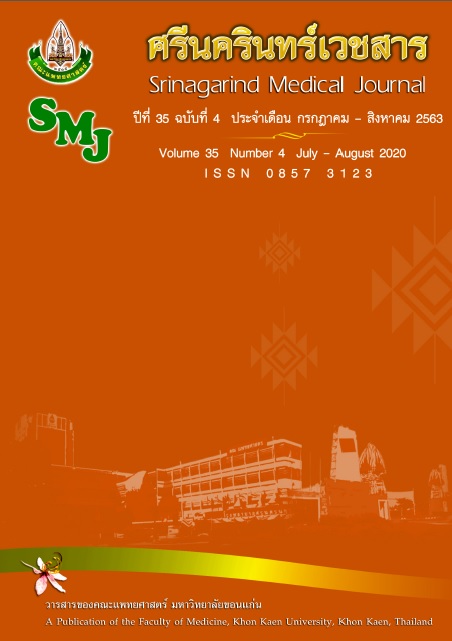Fear of Falling in Type 2 Diabetic Older Patients with and without Peripheral Neuropathy
Abstract
ความกลัวการหกล้มในผู้สูงอายุที่เป็นโรคเบาหวานชนิดที่ 2 ที่มีและไม่มีภาวะปลายประสาทเสื่อม
เบญญาภา ศรีปัญญา1*, ฉัตรชัย พีระวัธน์กุล2
1ภาควิชาอนามัยชุมชน คณะสาธารณสุขศาสตร์ มหาวิทยาลัยเกษตรศาสตร์ วิทยาเขตเฉลิมพระเกียรติ จังหวัดสกลนคร
2ภาควิชากายภาพบำบัด คณะเทคนิคการแพทย์ มหาวิทยาลัยเชียงใหม่
หลักการและวัตถุประสงค์: ผู้สูงอายุที่ป่วยด้วยโรคเบาหวานชนิดที่ 2 ที่มีระดับน้ำตาลในเลือดสูงเป็นเวลานานมักส่งผลให้เกิดภาวะปลายประสาทส่วนปลายเสื่อม ซึ่งเป็นปัจจัยเสี่ยงต่อการหกล้ม จากสาเหตุการสูญเสียความรู้สึกในการป้องกันตนเองที่เท้า นอกจากนี้ภาวะปลายประสาทส่วนปลายเสื่อมในผู้ป่วยเบาหวานน่าจะส่งผลให้ความกลัวการหกล้มสูงขึ้นด้วย และนำไปสู่การจำกัดการเคลื่อนไหวในชีวิตประจำวัน อย่างไรก็ตามยังไม่มีการศึกษาความกลัวการหกล้ม ของผู้สูงอายุที่ป่วยเป็นเบาหวานชนิดที่ 2 ที่มีและไม่มีภาวะปลายประสาทเสื่อมในประเทศไทย ดั้งนั้นการศึกษาครั้งนี้จึงมีวัตถุประสงค์เพื่อเปรียบเทียบความกลัวการหกล้มในผู้สูงอายุที่เป็นเบาหวานที่มีและไม่มีปลายประสาทเสื่อม และผู้สูงอายุที่มีสุขภาพดี
วิธีการศึกษา: อาสาสมัครทั้งหมดจำนวน 114 ราย แบ่งออกเป็นกลุ่มผู้สูงอายุที่ป่วยเป็นเบาหวานชนิดที่ 2 ที่มีภาวะปลายประสาทเสื่อม กลุ่มผู้สูงอายุที่ป่วยเป็นเบาหวานชนิดที่ 2 ที่ไม่มีภาวะปลายประสาทเสื่อม และกลุ่มผู้สูงอายุที่มีสุขภาพดี จำนวนกลุ่มละ 38 ราย อาสาสมัครทั้งหมดได้รับการประเมินความกลัวการหกล้ม ด้วยแบบประเมิน Falls Efficacy Scale-International (FES-I)
ผลการศึกษา: กลุ่มผู้สูงอายุที่ป่วยเป็นเบาหวานชนิดที่ 2 ที่มีภาวะปลายประสาทเสื่อมมีความกลัวการหกล้ม (33.36 ± 6.98) มากกว่าอย่างมีนัยสำคัญทางสถิติเมื่อเทียบกับกลุ่มผู้สูงอายุที่ป่วยเป็นเบาหวานชนิดที่2 ที่ไม่มีภาวะปลายประสาทเสื่อม (24.34 ± 6.76) และกลุ่มผู้สูงอายุที่มีสุขภาพดี (16.39 ± 0.50) (p < 0.05) นอกจากนี้ผู้สูงอายุที่ป่วยเป็นเบาหวานชนิดที่ 2 ที่ไม่มีภาวะปลายประสาทเสื่อมมีความกลัวการหกล้มมากกว่ากลุ่มผู้สูงอายุที่มีสุขภาพดีอย่างมีนัยสำคัญทางสถิติ (p < 0.05)
สรุป: ผู้สูงอายุที่ป่วยเป็นเบาหวานชนิดที่ 2 ที่มีภาวะปลายประสาทเสื่อมมีความกลัวการหกล้มมากกว่ากลุ่มผู้ป่วยเบาหวานที่ไม่มีภาวะปลายประสาทเสื่อมและผู้สูงอายุที่มีสุขภาพดี ซึ่งเป็นปัจจัยเสี่ยงสำคัญต่อการหกล้มในผู้สูงอายุ
คำสำคัญ: โรคเบาหวานชนิดที่ 2; ภาวะปลายประสาทเสื่อม; ความกลัวการหกล้ม; ผู้สูงอายุ
Background and Objective: Older adults with type 2 diabetic mellitus have long-term hyperglycemia that leads to peripheral neuropathy. Diabetic peripheral neuropathy (DPN) leads to loss of protective sensitivity of foot, resulting to falling in diabetic patients. In addition, DPN may be increase fear of falling (FOF) and lead to a limitation of the performance of daily activity. However, the associations between the FOF and type 2 diabetic older patients with and without peripheral neuropathy in Thailand have not been study yet. Thus, the propose of this study was to compare the fear of falling in older adults with and without type 2 diabetic peripheral neuropathy and healthy older adults.
Methods: One hundred fourteen participants were divided into three groups; i) type 2 diabetic older patients with peripheral neuropathy group (n = 38), ii) type 2 diabetic older patients without peripheral neuropathy group (n= 38) and, iii) normal elderly group (n = 38). All subjects were evaluated FOF by the Falls Efficacy Scale-International (FES-I).
Results: Type 2 diabetic older patients with peripheral neuropathy group showed significantly higher scores of FOF test (33.36±6.98) as compared to those of the type 2 diabetic older patients without peripheral neuropathy group (24.34±6.76) and the healthy older adult group (16.39±0.50) (p < 0.05). Moreover, FOF score in the type 2 diabetic older patients without peripheral neuropathy group was significant higher than healthy older adult group (p < 0.05).
Conclusion: The FOF in type 2 diabetic older patients with peripheral neuropathy was higher than type 2 diabetic older patients without peripheral neuropathy and healthy older adult, which was a main contributory factor of falling among elderly.
Keyword: Type 2 Diabetic Mellitus; Peripheral; neuropathy; Fear of falling; Older adult


